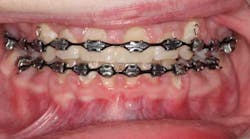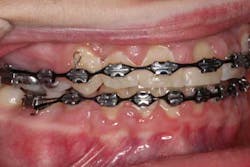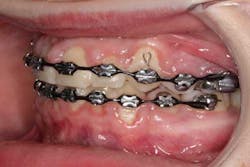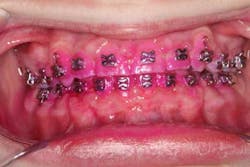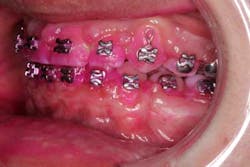The benefits of removing orthodontic hardware during recare appointments
I am a general dentist who does not do orthodontics. I do, however, have several patients who benefit from the services provided from local orthodontists. Since recare is maintained at my office, it is crucial that both providers are on board with several things during the course of treatment. Arguably, the most common and critical is home care.
ALSO BY DR. STACEY SIMMONS |Impacted canines and orthodontic treatment
Teens and preteens are notoriously known for their less-than-par oral health home-care skills, but when you put braces into the equation, then a high caries situation can easily multiply. I like to do all I can to help these patients when they come in for their recare appointments. It is an opportunity to get them to see and understand why they are a major player in the long-term success and prognosis of their oral health.
ALSO BY DR. STACEY SIMMONS |Consideration of nonsurgical compromises in Class II orthodontic cases
I have found that my auxiliary staff — namely assistants and hygienists — are excellent mediators of this push for education and the know-how’s of executing detailed home care.
When a patient presents like this for a recare exam, it is clear that the red, bulbous gums and layers of plaque are a problem. My hygienist is supposed to clean around all of the hardware and get all the plaque off effectively? All too often prophys are done on these patients with all this “stuff” on. Despite these efforts, realistically, everything does not get removed.
I have fantastic hygienists, but why make them work hard when the wires and bands can come off? Proper management of plaque and tartar can be more easily achieved if difficult access is taken out of the equation. One of the most common reasons why recare exams are done with the wires in place is because there is lack of knowledge about the removal and placement of these parts or there is concern that something will get “messed up.”
If that’s the case, then let’s consider a simple resolution. Training your assistant (and hygienist) to take off wires and bands during a recare appointment will not only allow your team members to be effective, it provides an opportunity for very effective home-care instruction. Disclosing agent, without wires and bands on, is a profound visual aid for any patient to critique his or her home-care skills.
Each provider has his or her own preference for orthodontic systems. I have two assistants who are skilled and competent to remove and replace the wires and bands for any of these systems. This has made a tremendous impact on the ability of my hygienists to be effectively productive in the amount of time that they have with our orthodontic patients, who more often than not have mass amounts of plaque and tartar that need to be removed.
I am an advocate of inner colleague collaboration, especially with specialists. I routinely seek advice and exchange information in order to better my understanding of the different disciplines in dentistry. This could be taken a step further to educate staff and allow them the opportunity to obtain skills that will benefit the practice. All too often, we think that continuing our education has to be at a seminar or learned online, when in reality, the best and most effective ways to learn are in time spent with our colleagues down the street! If your assistants, and if possible your hygienists, can spend a day or even a half day with the orthodontist to learn simple skills, then it is a win/win for all involved.
Maximize your resources with your colleagues. Offer opportunities for your staff members to expand their skills. Most importantly, by doing this, you will provide the best service possible for your patients!
